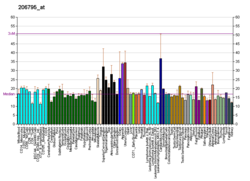プロテアーゼ活性化受容体3
| F2RL2 | |||||||||||||||||||||||||
|---|---|---|---|---|---|---|---|---|---|---|---|---|---|---|---|---|---|---|---|---|---|---|---|---|---|
| 識別子 | |||||||||||||||||||||||||
| 記号 | F2RL2, PAR-3, PAR3, coagulation factor II thrombin receptor like 2 | ||||||||||||||||||||||||
| 外部ID | OMIM: 601919 MGI: 1298208 HomoloGene: 36151 GeneCards: F2RL2 | ||||||||||||||||||||||||
| |||||||||||||||||||||||||
| |||||||||||||||||||||||||
| |||||||||||||||||||||||||
| |||||||||||||||||||||||||
| オルソログ | |||||||||||||||||||||||||
| 種 | ヒト | マウス | |||||||||||||||||||||||
| Entrez |
|
| |||||||||||||||||||||||
| Ensembl |
|
| |||||||||||||||||||||||
| UniProt |
|
| |||||||||||||||||||||||
| RefSeq (mRNA) |
|
| |||||||||||||||||||||||
| RefSeq (タンパク質) |
|
| |||||||||||||||||||||||
| 場所 (UCSC) | Chr 5: 76.62 – 76.62 Mb | Chr 5: 95.83 – 95.84 Mb | |||||||||||||||||||||||
| PubMed検索 | [3] | [4] | |||||||||||||||||||||||
| ウィキデータ | |||||||||||||||||||||||||
| |||||||||||||||||||||||||
プロテアーゼ活性化受容体3(プロテアーゼかっせいかじゅようたい3、英: protease-activated receptor 3、略称: PAR3)は、ヒトではF2RL2遺伝子にコードされるタンパク質である。F2RL2(coagulation factor II receptor-like 2)、thrombin receptor-like 2という名称でも知られる。
機能
PAR3はGタンパク質と共役した7回膜貫通受容体ファミリーに属する。また、プロテアーゼ活性化受容体ファミリーのメンバーでもあり、トロンビンによって活性化される。PAR3は細胞外のN末端領域のタンパク質分解切断によって活性化され、新たに形成されたN末端がテザードリガンドとして受容体を活性化する。PAR3はトロンビンによるPAR4の切断と活性化のコファクターとしても機能する[5][6]。
出典
- ^ a b c GRCh38: Ensembl release 89: ENSG00000164220 - Ensembl, May 2017
- ^ a b c GRCm38: Ensembl release 89: ENSMUSG00000021675 - Ensembl, May 2017
- ^ Human PubMed Reference:
- ^ Mouse PubMed Reference:
- ^ “Entrez Gene: F2RL2 coagulation factor II (thrombin) receptor-like 2”. 2021年9月5日閲覧。
- ^ Nakanishi-Matsui, M.; Zheng, Y. W.; Sulciner, D. J.; Weiss, E. J.; Ludeman, M. J.; Coughlin, S. R. (2000-04-06). “PAR3 is a cofactor for PAR4 activation by thrombin”. Nature 404 (6778): 609–613. doi:10.1038/35007085. ISSN 0028-0836. PMID 10766244. https://pubmed.ncbi.nlm.nih.gov/10766244.
関連文献
- “International Union of Pharmacology. XXVIII. Proteinase-activated receptors.”. Pharmacol. Rev. 54 (2): 203–17. (2002). doi:10.1124/pr.54.2.203. PMID 12037136.
- “Protease-activated receptor 3 is a second thrombin receptor in humans.”. Nature 386 (6624): 502–6. (1997). Bibcode: 1997Natur.386..502I. doi:10.1038/386502a0. PMID 9087410.
- “The human proteinase-activated receptor-3 (PAR-3) gene. Identification within a Par gene cluster and characterization in vascular endothelial cells and platelets.”. J. Biol. Chem. 273 (24): 15061–8. (1998). doi:10.1074/jbc.273.24.15061. PMID 9614115.
- “Cloning and characterization of human protease-activated receptor 4”. Proc. Natl. Acad. Sci. U.S.A. 95 (12): 6642–6. (1998). Bibcode: 1998PNAS...95.6642X. doi:10.1073/pnas.95.12.6642. PMC 22580. PMID 9618465. https://www.ncbi.nlm.nih.gov/pmc/articles/PMC22580/.
- “Protease-activated receptor genes are clustered on 5q13”. Blood 92 (1): 25–31. (1998). doi:10.1182/blood.V92.1.25.413k41_25_31. PMID 9639495.
- “A dual thrombin receptor system for platelet activation”. Nature 394 (6694): 690–4. (1998). Bibcode: 1998Natur.394..690K. doi:10.1038/29325. PMID 9716134.
- “Gene and locus structure and chromosomal localization of the protease-activated receptor gene family”. J. Biol. Chem. 273 (36): 23290–6. (1998). doi:10.1074/jbc.273.36.23290. PMID 9722561.
- “Protease-activated receptors 1 and 4 mediate activation of human platelets by thrombin”. J. Clin. Invest. 103 (6): 879–87. (1999). doi:10.1172/JCI6042. PMC 408153. PMID 10079109. https://www.ncbi.nlm.nih.gov/pmc/articles/PMC408153/.
- “alpha-Thrombin stimulates contraction of human bronchial rings by activation of protease-activated receptors”. Am. J. Physiol. 277 (1 Pt 1): L22–9. (1999). doi:10.1152/ajplung.1999.277.1.L22. PMID 10409227.
- “PAR3 is a cofactor for PAR4 activation by thrombin”. Nature 404 (6778): 609–13. (2000). Bibcode: 2000Natur.404..609N. doi:10.1038/35007085. PMID 10766244.
- “Thrombin responses in human endothelial cells. Contributions from receptors other than PAR1 include the transactivation of PAR2 by thrombin-cleaved PAR1”. J. Biol. Chem. 275 (18): 13502–9. (2000). doi:10.1074/jbc.275.18.13502. PMID 10788464.
- “Neutrophil proteases can inactivate human PAR3 and abolish the co-receptor function of PAR3 on murine platelets”. Thromb. Haemost. 85 (3): 533–8. (2001). doi:10.1055/s-0037-1615617. PMID 11307827.
- “Role of thrombin signalling in platelets in haemostasis and thrombosis”. Nature 413 (6851): 74–8. (2001). Bibcode: 2001Natur.413...74S. doi:10.1038/35092573. PMID 11544528.
- “Trypsin induces activation and inflammatory mediator release from human eosinophils through protease-activated receptor-2”. J. Immunol. 167 (11): 6615–22. (2002). doi:10.4049/jimmunol.167.11.6615. PMID 11714832.
- “Generation and initial analysis of more than 15,000 full-length human and mouse cDNA sequences”. Proc. Natl. Acad. Sci. U.S.A. 99 (26): 16899–903. (2003). doi:10.1073/pnas.242603899. PMC 139241. PMID 12477932. https://www.ncbi.nlm.nih.gov/pmc/articles/PMC139241/.
- “The pattern of expression of protease-activated receptors (PARs) during early trophoblast development”. J. Pathol. 200 (1): 47–52. (2003). doi:10.1002/path.1338. PMID 12692840.
- Owen WG (2003). “PAR-3 is a low-affinity substrate, high affinity effector of thrombin”. Biochem. Biophys. Res. Commun. 305 (1): 166–8. doi:10.1016/S0006-291X(03)00732-0. PMID 12732212.
- “Thrombin-induced Ca2+ mobilization in human gingival fibroblasts is mediated by protease-activated receptor-1 (PAR-1)”. Life Sci. 73 (3): 301–10. (2003). doi:10.1016/S0024-3205(03)00269-8. PMID 12757837.
関連項目
- 表示
- 編集













